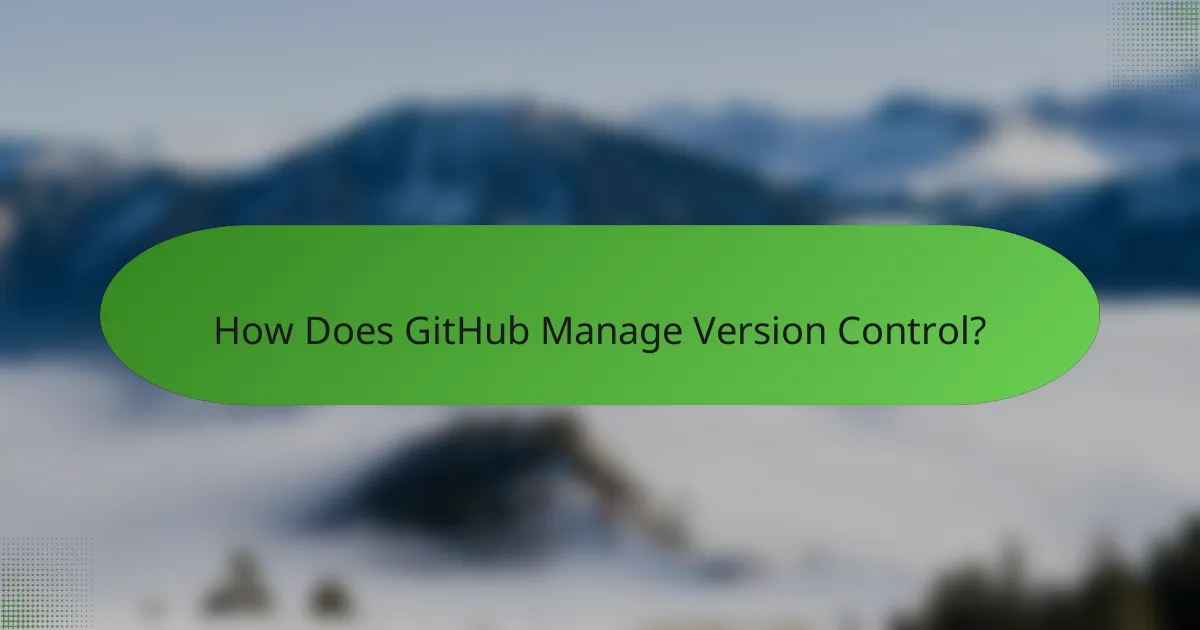GitHub serves as a powerful platform for showcasing projects, fostering collaboration, and managing version control. By utilizing features like README files and GitHub Pages, developers can effectively present their work and engage with the community. Additionally, GitHub’s collaboration tools, such as pull requests and issue tracking, streamline teamwork, while its version control system ensures organized and efficient development processes.

How to Showcase Projects on GitHub?
Showcasing projects on GitHub effectively involves creating a clear and engaging presentation of your work. This includes using essential features like README files, GitHub Pages, and community engagement to attract attention and collaboration.
Create a README file
A README file is crucial for any GitHub project as it provides an overview and instructions for users. It should include a project title, description, installation guidelines, usage examples, and any relevant links.
To make your README stand out, consider using Markdown for formatting. This allows you to include headings, lists, and images, making the document visually appealing and easy to read.
Use GitHub Pages for demos
GitHub Pages allows you to host a live demo of your project directly from your repository. This feature is particularly useful for web applications, as it enables potential users to interact with your project without needing to download anything.
To set up GitHub Pages, navigate to your repository settings and enable the feature. You can choose to serve from the main branch or a dedicated branch like ‘gh-pages’.
Highlight key features in the repository
Highlighting key features within your repository helps users quickly understand the value of your project. Use the README file to emphasize unique functionalities and benefits, and consider adding a dedicated section for features.
Additionally, you can create a ‘Features’ folder in your repository that includes detailed documentation or examples of each feature, making it easier for users to explore.
Utilize GitHub Actions for automation
GitHub Actions enables you to automate workflows directly in your repository. This can include tasks like running tests, deploying code, or sending notifications upon certain triggers.
To implement GitHub Actions, create a workflow file in the ‘.github/workflows’ directory. Define the events that trigger the workflow and specify the jobs to be executed, ensuring your project remains efficient and up-to-date.
Engage with the community through issues
Engaging with the community via GitHub Issues is essential for feedback and collaboration. Encourage users to report bugs, request features, or ask questions, creating an interactive environment around your project.
Be proactive in responding to issues and comments. This not only helps improve your project but also fosters a sense of community and encourages more contributions from users.

What Collaboration Features Does GitHub Offer?
GitHub provides a range of collaboration features designed to enhance teamwork and streamline the development process. Key functionalities include pull requests for code review, issues for task tracking, projects for organizing work, and discussions for community engagement.
Pull requests for code review
Pull requests are a core feature of GitHub that facilitate code review and collaboration. When a developer wants to merge changes into a project, they create a pull request, allowing team members to review the code, suggest modifications, and discuss improvements before final integration.
To effectively use pull requests, ensure that you provide clear descriptions and context for your changes. This helps reviewers understand the purpose and scope of the modifications. Aim for concise, focused pull requests to make the review process smoother.
Issues for tracking tasks
GitHub Issues serve as a powerful tool for tracking tasks, bugs, and feature requests within a project. Each issue can be assigned to team members, labeled for categorization, and prioritized to manage workflow effectively.
When creating issues, use descriptive titles and detailed descriptions to clarify the task at hand. Consider using templates for common tasks to maintain consistency. Regularly review and update issues to reflect progress and ensure accountability among team members.
Projects for organizing work
GitHub Projects provide a visual way to organize and manage work through boards that can include tasks, issues, and pull requests. This feature allows teams to track progress and prioritize tasks using a Kanban-style layout.
To maximize the effectiveness of GitHub Projects, categorize tasks into columns such as “To Do,” “In Progress,” and “Done.” This visual representation helps teams quickly assess project status and identify bottlenecks in the workflow.
Discussions for community engagement
Discussions on GitHub enable teams and communities to engage in conversations about project ideas, feedback, and general topics. This feature fosters collaboration beyond code, allowing for brainstorming and sharing knowledge among contributors.
Encourage team members to participate in discussions by asking open-ended questions and sharing insights. Use discussions to gather input on new features or to resolve conflicts, ensuring that all voices are heard in the decision-making process.

How Does GitHub Manage Version Control?
GitHub manages version control through a structured system that allows developers to track changes, collaborate on projects, and maintain different versions of their code. This system is built around key concepts such as branching, commits, tags, and conflict resolution, which facilitate organized and efficient development workflows.
Branching for feature development
Branching in GitHub allows developers to create separate lines of development for new features or fixes without affecting the main codebase. Each branch can be worked on independently, enabling teams to experiment and make changes without risking the stability of the main project.
When creating a branch, it’s best to use descriptive names that reflect the feature being developed, such as “feature/login-page” or “bugfix/header-issue.” This practice helps maintain clarity and organization within the project.
Commits for tracking changes
Commits serve as snapshots of the project at specific points in time, allowing developers to track changes and understand the evolution of the codebase. Each commit should include a clear message that describes the changes made, which aids in future reference and collaboration.
It’s advisable to commit changes frequently, ideally after completing a logical unit of work. This habit not only helps in maintaining a detailed history but also makes it easier to identify and revert problematic changes if necessary.
Tags for version releases
Tags in GitHub are used to mark specific points in the repository’s history as significant, often corresponding to version releases. By tagging releases, developers can easily reference stable versions of their software, which is particularly useful for deployment and distribution.
When creating tags, follow semantic versioning conventions (e.g., v1.0.0) to provide clear information about the release’s significance. This practice helps users and collaborators understand the changes and improvements made in each version.
Merge conflicts resolution
Merge conflicts occur when changes from different branches overlap, preventing Git from automatically merging them. Resolving these conflicts requires manual intervention, where developers must review the conflicting changes and decide how to integrate them.
To minimize merge conflicts, communicate frequently with team members about ongoing changes and consider merging branches regularly. When conflicts do arise, use GitHub’s conflict resolution tools to compare changes side by side, making it easier to choose the correct code to keep.

What Are the Best Practices for GitHub Collaboration?
Effective collaboration on GitHub hinges on clear communication, structured processes, and consistent practices. By following best practices, teams can enhance productivity and minimize conflicts during development.
Establish a clear contribution guide
A well-defined contribution guide is essential for any collaborative project on GitHub. It should outline how contributors can participate, including coding standards, branch naming conventions, and the process for submitting pull requests.
Consider including sections on how to report issues, request features, and the review process. This clarity helps new contributors understand expectations and reduces the likelihood of misunderstandings.
Use consistent commit messages
Consistent commit messages improve project clarity and history tracking. A good practice is to start each message with a verb, such as “Add,” “Fix,” or “Update,” followed by a brief description of the change.
For example, instead of a vague message like “Changes made,” use “Fix typo in README.md.” This approach makes it easier for team members to understand the project’s evolution and identify specific changes quickly.
Maintain a clean project structure
A clean project structure enhances navigability and usability for all contributors. Organize files logically, grouping related components together and using clear naming conventions for directories and files.
For instance, separate source code, documentation, and tests into distinct folders. This organization not only aids current collaborators but also makes onboarding new contributors smoother.

What Tools Integrate with GitHub for Enhanced Collaboration?
Several tools integrate with GitHub to improve collaboration among teams, enhancing productivity and streamlining workflows. These integrations facilitate communication, project management, and code quality checks, making it easier for teams to work together effectively.
Project Management Tools
Project management tools like Trello, Jira, and Asana can be integrated with GitHub to track issues and manage tasks directly from the repository. This integration allows teams to link commits and pull requests to specific tasks, providing clear visibility into project progress.
When using these tools, consider setting up automation to update task statuses based on GitHub activity. For example, moving a Trello card to “Done” when a pull request is merged can save time and reduce manual updates.
Continuous Integration/Continuous Deployment (CI/CD) Tools
CI/CD tools such as CircleCI, Travis CI, and GitHub Actions work seamlessly with GitHub to automate testing and deployment processes. These tools help ensure that code changes are tested automatically, reducing the chances of introducing bugs into production.
To maximize the benefits, configure your CI/CD pipeline to run tests on every pull request. This practice helps catch issues early and maintains a high standard of code quality throughout the development cycle.
Communication Platforms
Integrating communication platforms like Slack or Microsoft Teams with GitHub enhances real-time collaboration. Notifications about pull requests, issues, and commits can be sent directly to team channels, keeping everyone informed without needing to constantly check GitHub.
To set this up, use webhooks or dedicated integrations that allow GitHub to send updates to your chosen communication platform. This setup fosters a more responsive team environment and helps address issues as they arise.
Code Review Tools
Code review tools such as Reviewable and CodeClimate can be integrated with GitHub to streamline the review process. These tools provide features like inline comments and automated feedback, making it easier for teams to maintain code quality and consistency.
Encourage team members to use these tools for every pull request to ensure thorough reviews. Setting a guideline for response times can help keep the review process efficient and prevent bottlenecks in development.
